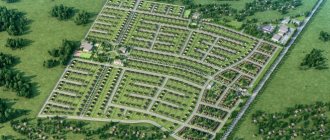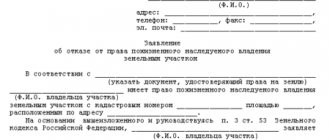One of the most popular types of land use during construction is individual housing construction. It allows you to build single-family residential buildings, household and utility rooms .
Most often, individual housing construction is used in large cities closer to the center. In small towns, villages and on the outskirts of large cities, individual housing construction competes with the VRI of the land “Personal subsidiary plot”.
Differences between plots for individual housing construction and lands of other categories
The list of land offers is not limited to plots whose names contain only the abbreviation individual housing construction. There are also areas such as DNT, SNT and others. These abbreviations indicate a specific type of ownership of a particular plot of land. But the most in demand is land that belongs specifically to this category.
First, it should be mentioned how the individual housing construction plot is deciphered. This is an abbreviation that means “individual housing construction”. Looking ahead, we note that the purchase of such a plot allows the use of maternity capital. In addition, this financial transaction is subject to the possibility of applying a tax deduction. This will be discussed in more detail below.
If the site belongs to the category “land for individual housing construction”, this means that the territory is intended for the construction of a private house according to an individual project. Based on this formulation, experts are unanimous in their opinion regarding cases when the allotment according to the documents officially falls under this category.
If the future owners of the land intend to live permanently in the constructed house, register there and obtain a postal address, they should purchase only such a plot.
It should be explained what the status of individual housing construction means in relation to the building. First of all, it should have no more than three floors. In addition, according to Art. 49, in the territory of urban settlements and districts, the development and configuration of individual housing construction must comply with the general plan of the settlement.
Each land plot is characterized by the type of permitted use, the determination of which is the prerogative of specialists at the local administration. Therefore, it is useful to know the difference between SNT and individual housing construction. By the way, the abbreviation SNT means “horticultural non-profit partnership.”
Differences between sections of these categories:
- An allotment for individual housing construction is usually located within the boundaries of an urban settlement or municipality. The SNT land has exclusively agricultural purposes.
- On land for individual housing construction, you can build a residential building with a height of no more than 3 floors. On SNT sites, only the construction of country houses is allowed.
- Registration of permanent registration on an allotment for individual housing construction does not involve any difficulties, but in order to register on SNT land, you must first apply for recognition of the building as residential and put it into operation.
- Since the plots for individual housing construction are located on the territory of the settlement, their improvement is financed from the local budget. Budget funds are also used to develop infrastructure around SNT, but its internal territory is improved only through contributions from members of the partnership.
If we are talking about abbreviations, it is also worth mentioning the concept of DNP - “dacha non-profit partnership” and private household plot - “personal subsidiary plot.
More information on this issue can be obtained in the article “Categories of land in the Russian Federation”.
Lands of settlements
Chapter XV of the Land Code of the Russian Federation is devoted to the definition of territories occupied by urban and rural settlements. According to the law, the land of settlements is considered to be areas occupied by various buildings for the development of cities and villages, as well as surface spaces intended for construction for these purposes. The requirements for establishing the boundaries of such areas are set out in Article 83 of the Land Code of the Russian Federation.
All settlement lands are subject to territorial zoning, and the plots obtained during land surveying must be located within only one of the possible zones. The town planning regulations clearly define the building standards and types of construction projects allowed for construction on a site belonging to a specific zone. There are areas designed for residential, industrial, public buildings, intended for real estate for agriculture, recreational purposes, areas for military facilities, engineering and transport networks, etc.
Various subtypes of land in settlements allow for the possibility of construction established by law. The classifier, approved by Order of the Ministry of Economic Development of the Russian Federation No. 540 dated September 1, 2014, specifies the list of goals for the achievement of which it is legal to use plots of settlement land. The types of buildings identified for construction within each of the territorial zones are given in Article 85 of the Land Code of the Russian Federation.
Areas of land within the boundaries of a settlement have their own rules of operation. Permitted use provisions are required to be followed by all site owners. In the case when immovable objects of certain regions on the lands of settlements do not comply with regulations, but do not threaten the life and health of people, the environment and cultural monuments, their existence does not contradict the law (Clause 4 of Article 85 of the Land Code of the Russian Federation).
Advantages of plots for individual housing construction
The main advantages of plots for individual construction lie in the specific design of the housing built on them. This issue was partially touched upon above, but it is worth clarifying some points.
- Purchasing land for building a house is accompanied by significant costs for the construction of the structure. If, due to a lack of funds, you have to turn to the bank for a loan, the financial institution will provide a large loan secured by a plot of land for individual housing construction.
- Since the plots of this category are located within populated areas, connecting to utilities, primarily to water and electricity supply systems, is not particularly difficult.
- Reducing fiscal fees. Knowing how much the land costs, you can calculate the amount of tax deduction provided for by law. The state will return 13% of the transaction amount to the buyer of the plot for individual housing construction. In this case, the amount of costs for acquiring a plot of land is not more than 2 million rubles. That is, a maximum of 260,000 rubles is returned.
- Independence. This is ensured by the isolation of a site located in a populated area for individual housing construction. And this is, perhaps, the most significant difference between plots for construction and those intended for gardening or a holiday village. By purchasing plots of the last two categories, a citizen becomes a member of partnerships/partnerships. That is, he is forced to: pay fees - entrance and target;
- sign a service agreement with a specific company;
- conclude an agreement for the use of utilities, and so on.
The owner of the plot for individual housing construction does not have to do this.
Allotments in the DNP and areas for private household plots also have some peculiarities. The acquisition of private household plot land has certain advantages over having ownership rights to land use plots of other categories.
Details are contained in the article “Land for private household plots and individual housing construction: what is the difference.”
Advantages and disadvantages of plots for residential construction
The advantages of plots for individual housing construction are determined, first of all, by their location on the territory of a populated area. Among the advantages we can list that:
- authorities are obliged to maintain roads in good condition, monitor the infrastructure of the land: public transport stops, shops, hospitals, schools should be located nearby;
- on plots of this category, the construction of outbuildings and the arrangement of a vegetable garden or garden are allowed;
- owners are given the opportunity to apply for a tax deduction.
But the individual housing construction type of land is by no means an ideal form of ownership. It also has some disadvantages, in particular:
- a plot of this category cannot exceed the area established by law. This norm varies in regions and is determined by the decision of local governments;
- The construction of a residential private house is regulated by a large number of regulations. Therefore, at each stage of construction of a building, a citizen will have to draw up the appropriate package of documents and take into account the requirements of various GOSTs and SNiPs. This will take a lot of time. And the commissioning procedure is extremely bureaucratic.
Legislative norms for the use of land for individual housing construction
What private housing construction is has already been mentioned above. In addition to the number of storeys, in paragraph 39 of Art. 1 of the Land Code of the Russian Federation stipulates the requirement for the total height of the building - it should not exceed 20 meters.
One of the key characteristics of a house is its indivisibility into independent real estate units.
In addition to rooms, it may contain auxiliary premises intended to satisfy residents’ household and other needs.
In August 2018, the legislation underwent changes regarding the issue of using land for individual housing construction. Then came into force. According to its provisions, the procedure for starting and finishing the construction of an individual housing construction project is of a notification nature.
The developer is not required to obtain permission to carry out work. It is enough just to notify the authorized body.
By the way, this is the fundamental difference between individual housing construction land and SNT land under the new law. To build a residential building on a garden plot, you need to obtain permission from the town planning department of the district government at the location of the plot.
What is the category of land?
The Land Code in force in the country contains definitions of various categories of land. These are groups of plots united by their intended purpose, which can only be used within the framework of the purposes specified for them by law.
The division of the land fund into categories was adopted to improve control over its use. In case of violation of certain requirements of the RF Land Code for the exploitation of land plots, they can be seized by the state from the owners.
Norms for developing a site for individual housing construction
Recently, there have been no changes in construction standards on sites in this category. So, when building a house in this case, you should be guided by the provisions. In particular, an individual housing construction project must have a total area of no more than 1.5 thousand m2. In addition, when developing a site, you must maintain the established distances from the building:
- to the passage – 3 m,
- to the road – 5 m.
Rules for placing fences also apply. For example, it should be remembered that the distance of the fence from the house must be at least 3 m. Non-residential buildings can be located at a distance of 1 m from the structure enclosing the site.
Everything that can be done on individual housing construction lands is also regulated by SNiPs. In particular, if the plot is located in a hilly area or close to a forest or reservoir, the owner will have to create a fortified foundation or obtain permission to cut down trees.
Who and what buildings can build on land for individual housing construction
The main document regulating construction work on plots for individual housing construction is the Town Planning Code of the Russian Federation. Typically, such land plots are used for the construction of a cottage. In this case, the internal structure of the structure must meet the following requirements:
- ceiling height – 2.5 m;
- bedroom size – at least 8 m2;
- living room area – from 12 m2;
- the total area of the bathroom is at least 2.7 m2.
It is allowed to build a garage on the site. Moreover, the SNiP standards regarding the size of this building are advisory in nature. The only things that must be observed are the distance between the garage and the fence, as well as from your own and neighboring houses.
In addition, the category of land for individual housing construction allows the owner to build:
- bathhouse,
- barn,
- canopy,
- built-in/attached veranda,
- gazebo,
- toilet.
If we talk about who can build structures on such a site, then when choosing a counterparty company, you need to make sure that it has permission to build a private house.
Today we have mentioned cadastral engineers more than once, how to choose one, what should you pay attention to?
When choosing a cadastral engineer, the Rosreestr Office for the Kurgan Region recommends referring to the rating of specialists operating in the Trans-Ural region, published quarterly on the official website of Rosreestr - www.rosreestr.ru.
The rating is based on the share of decisions made on suspensions and refusals in state cadastral registration of the total volume of documents submitted by these specialists. The lower the share of suspensions and refusals in state cadastral registration in practice, the correspondingly higher the quality of the prepared documents.
To get acquainted with the rating, you need to go to the official website of Rosreestr (www.rosreestr.ru), select the region “Kurgan Region”, section “Open Service” / “Statistics and Analytics” / “Rating of Cadastral Engineers”.
You can also find out the contacts of the cadastral engineer you are interested in through the Rosreestr website. We select the “Individuals” section, where there is a “Register of Cadastral Engineers” tab, enter the last and first name of the specialist in the search bar, and get information about which self-regulatory organization of cadastral engineers he belongs to. Each such organization maintains a register of its specialists, where complete information about their activities is concentrated, including their addresses and telephone numbers.
How can you get a plot of land for individual housing construction for free?
The following can obtain land for the construction of a private house free of charge:
- citizens who support three or more young children. Parents must be officially married (have a marriage certificate) and have the status of a large family. Single parents can also have many children. The plot is provided once, and its area should not be less than 3 acres. The maximum value of this parameter differs in each region of the Russian Federation. The national average area is 30 acres;
- citizens of other categories in cases provided for by the legislation of the constituent entities of the Russian Federation, for example: holders of the Order of Labor Glory;
- Heroes of the Soviet Union;
- Heroes of Labor of the Russian Federation and so on.
The procedure for obtaining free land in the Land Code of the Russian Federation is described in general terms with reference to regional laws. However, the following stages can be distinguished:
- Submitting an application to the local government body for placement in the queue:
- collection of documents;
- waiting for the site to be provided;
- obtaining land.
To prevent the plot from being confiscated, it is recommended to begin construction in the very first year of registration of its ownership.
Limit sizes of land plot
Article 30 of the Town Planning Code established that the maximum sizes of all plots must be established by local town planning regulations .
That is, the size of the plot is determined at the level of administration to which it belongs. This could be the administration of a rural settlement or the administration of an entire subject of the Russian Federation.
At the same time, on the basis of SNiP, which established the minimum distances from one building to another and the distances from a building to the road, individual housing construction plots with an area of less than 3 acres are not provided .
Local authorities, based on their own capabilities, have the right to increase the minimum plot size.
Thus, in the Leningrad region plots of less than 10 acres are not provided.
In any case, the owner of the plot will not be able to obtain a building permit if the size of the plot is smaller than the minimum established value in the region.
There are no restrictions on maximum dimensions . Local authorities, based on available capabilities, have the right to provide a plot of any size. Thus, the largest plots are provided in the Moscow region - up to 30 acres.
The minimum and maximum sizes apply only when allocated by local authorities.
An individual or legal entity can buy several plots at the same time and combine them into one if technically possible (if the plots are located next to each other and if they all have the same VRI).
Among other things, the local administration may make a note in the town planning regulations that the minimum and maximum sizes are not subject to determination. In this case, the size of a specific plot is determined when it is sold (transferred, allocated) to a specific person.
Read more about size limits in another article.
How to purchase an allotment for individual housing construction
Let's figure out how to properly buy land for building a house. Although this procedure usually does not cause difficulties, in order not to waste time and money, you need to do the following in advance:
- make sure that the land is really intended for individual housing construction;
- find out the reasons for the purchase of the plot by the current owner and check the legality of his ownership;
- make sure there are no encumbrances on the land.
The purchase of land plots for individual housing construction itself includes the following stages:
- Applying to the city administration with an application for the allocation of an allotment.
- Waiting for a decision to be made. The local authority has 30 days to do this. If there are grounds, refusal is possible.
- When a positive decision is made, the authorities publish a notice on the Internet and the media about the sale of the land plot at auction.
- In the absence of other bidders or based on the results of the auction, the administration draws up a contract for the sale and purchase of the allotment.
In order for the transaction to go through without delays, you need to know what documents must be available when purchasing a land plot for individual housing construction. Let's briefly list them:
- a document indicating the purpose of the land;
- passport of a citizen of the Russian Federation;
- title document for the allotment;
- an extract from the Unified State Register of Encumbrances confirming the absence of encumbrances;
- registration certificate with a cadastral number assigned to the plot;
- technical certificate.
Lease of land from the administration for development
To rent a plot for individual housing construction, you need to complete the following steps:
- Order a copy of the site plan on a scale of 1:500 from the city administration.
- Select a site without objects under construction.
- Find out from the local administration whether it is possible to rent this plot of land.
- Make sure that there are no objects on the site that would impede construction.
- Submit a development application.
It may take several weeks for the authority to make a decision. If the consideration of the application is positive, an auction is held. A notice about it is published in the media and on the Internet.
Rent
It is not necessary to buy land right away; you can rent it, build a house, put it into operation, and then buy it back at a price of 2.5% of the cadastral value.
Procedure:
- Choose a plot yourself or participate in a public auction.
- Write an application to the administration at the location of the land about your intention to lease the plot.
- Officials check the land for ownership and encumbrances, compare its location with the master plan for building and development, and then render a verdict.
- Preparation and signing of the lease agreement.







